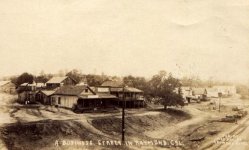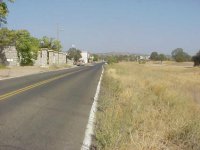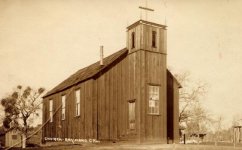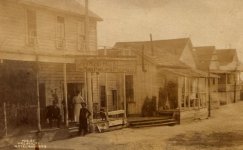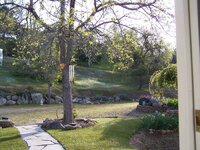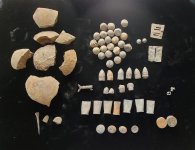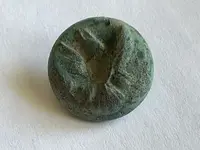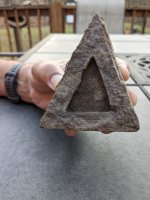Gypsy Heart
Gold Member
The History of Raymond
By Archibald Campbell Shaw
Raymond Tattler, March 1933
Early in the year 1886 Henry Washburn, manager of the Yosemite Stage and turnpike Company said to Mr. Mann, Southern Pacific Agent at San Francisco, “If we expect to get any tourist travel into Yosemite this year, we will have to start our stages from some other point than Madera because the rains have been so heavy there will be no bottom to the roads between Madera and the foothills.” After a hurried conference the S.P. decided to build a branch road from Berenda to a point about twenty-three miles into the foothills – stopping at a beautiful well-wooded flat called the Hog Ranch. The S.P. Company named this point Raymond, presumably after Mr. Raymond of the Raymond-Whitcomb Travel Association.
During March the first train carrying passengers puffed into Raymond. A tent hotel was erected near the big tree at the south-east corner depot by Walter Bowen, son of P. M. Bowen who played a prominent part in the history of Raymond.
The Stage Company began at once to built stables for their stock, shed for coaches and houses for drivers.
The coming of the Railroad opened up a new industry – the cutting and shipping of wood.
Charles Miller was appointed joint agent for the S.P. and Y.S. and T. Company. He homesteaded the one hundred and fifty acres comprising the town site of Raymond, laid out the town of Raymond and commenced to sell lots.
A little later A.R. (Sandy) Stevens homesteaded the hundred and sixty acres adjoining the north of the Miller townsite and he laid out four blocks into town lots.
Up to the time of the coming of the R.R. the country around Raymond was sparsely settled but the wood business brought in a host of homesteaders. This increased the population which called for stores, hotels, feed stores, post office, etc.
Walter Bowen was the first Post-Master. About this time, his father, P.M. Bowen, formerly of Goldbert-Bowen Company in San Francisco, built and opened up a store just east of the S.P. Station and adjoining it a hotel, replacing the tent hotel established by his son.
Thomas Lennard and Robert Maxwell built and opened a general store, hotel, saloon, and livery stable across the tack from the telephone office.
With the influx of population the need for a school was felt, and one night a public meeting was held, money subscribed and the next morning Harris Foster with a six animal team started for the Miami Mill for lumber. A one-room school-building son occupied the knoll west of Charles Potter’s home. Miss Judson was the first Grammar School teacher. Among her pupils were Sterling and Will Phillips, their sisters May Potter and Hattie Hildreth, Julius, Caesar, and Beatrice Vignola, Norman, Annie, Tone, and Lucy Foster.
This building was in constant use until 1909 when a new Grammar School building was erected. This, too, has many added improvements in recent years – a water system and play-ground equipment that does credit to its size.
After several unsuccessful attempts, a high school district was formed and held its first term in the little building that for so many years housed the Grammar School, and which was given to the High School by the Grammar School trustees.
In 1924 a contract was let to Alfred Wood for the building of the High School on its present site. From year to year improvements and additions have been made.
In 1887 Rev. Frickstadt built the Episcopal Church in the south end of town and served as its minister for a time. Rev. McGowan came next and later Rev. Nichols, who still lived in the hearts of many Raymondites.
Another church under the Presbyterian Diocese was organized about 1894, and is still one of the town institutions. Mr. Virgil Koontz was one of those responsible for its organization.
Improvements have been made from time to time – those added by Mr. and Mrs. Alfred Wood, especially improving the comfort and appearance of the little church.
As time went on, still more business houses started – boarding houses, restaurants, feed yards, and saloons.
The towns of Coarse Gold, Fresno Flats, Grub Gulch, Gertrude, Fish Camp, Wawona, and Yosemite, which formerly received their freight and supplies from Fresno, Madera, and Merced, were now supplied through Raymond, making it one of the biggest freight-distributing points in the South San Joaquin Valley. All kinds and sizes of freight teams – fours, sixes, eights and tens – the latter two being handled with a jerk-line – went rolling in and out of Raymond with freight for the mountains. These teams and others hauling wood, etc. presented a typical western picture that may never be seen again.
Soon after the coming of the R.R. Frank Ducey, a contractor from Fresno, saw the possibilities of utilizing some of the immense deposits of granite around Raymond, so he bought from Luke David a quarter section of land containing therein a prot of the quarry which was later purchased by F.E. Konwles and Able Hosmer. These men at first hauled their granite from their quarry to a switch just east of the junction of the Buchanan Road, but soon found that this method was not profitable, so they set to work building a spur into their quarry, and were able to laod the stone onto cars from theirs sheds and quarry. Their business grew rapidly – thereby making an increase in equipment necessary. One of their first big jobs was the San Francisco Post Office, at which time about two hundred fifty men were employed.
During the period 1890 to 1904 several granite companies operated in this vicinity. The McLennan Granite Company operated for several years. Then the quarry was taken over by Wilson-Lyon Construction Company and they in turn were succeeded by the McGilvray Company.
About 1893, J.G. and I.N. Day Construction Company was awarded the contract for the locks at Dalles, Oregon and opened up a quarry on their property two and a half miles south of Raymond, employing about one hundred men and shipping a large amount of granite.
In 1891-92 Alex Mann operated a quarry north-east of town. In this same period Wood, Johnny Milne and Knudson operated another near the Mann quarry.
In later years when machinery became a great factor in the manufacture of finished granite, the small quarries were eliminated, leaving the two larger companies, Raymond Granite Company and the McGilvray Granite Company – these two consolidating in 1928.
In passing, an interesting point in the acquisition of the present quarry is worthy of note. This quarry was located upon by Luke David, very reluctantly. He wanted a spring and a certain piece of creek bottom and had to take along with these a seemingly worthless pile of rocks – which is now conceded – by granite men – taking into consideration accessibility, quality, quantity and ease of working, the largest and best building granite in the world.
The Raymond Granite can be recognized in many California buildings by its gray-white color.
Quarrymen and stone-cutters received their mail and did much trading in Raymond – many made their homes here – thus contributing much to the growth of population and the increase in business.
There have been many interesting personalities among the old-timers, who have played their parts and gone away leaving vivid impressions on those who remain.
Well-known of those who remain is David Dapelo, who moved into Raymond from Quartz Mountain and opened a restaurant in the little building just north of the telephone office. At about the same time Charles Tann and Johnnie Vignola opened up a blacksmith shop; Billie Fields had a saloon; Ed Skelton had a place where drinks were served; Sam Ryan had a saloon where Krohns meat market now operates; Dare Lewis had a butcher shop where Phillip’s store now is.
Early in the history of Raymond, Grandma and Grandpa Skelton, from Jerseydale, Mariposa County, came to Raymond and started a boarding house in the building which Ole Osmundson has remodeled and in which he lives. Few people work their way into the hearts of their neighbors or linger as tenderly in the memories of old timers as did those two old folks, the Skeltons, with their kindly ways and friendly neighborliness.
In 1890 the Yosemite Stage and Turnpike Company built a commodious hotel for the accommodation of the Yosemite Tourists. Mr. Glascock was the first manager, and two years later Miller and Baxter. Upon the death of Charles Miller the hotel was leased to Mr. and Mrs. George Leidig who for years operated the Leidig Hotel. Mrs. Leidig’s fame as a cook was spread world-wide by the tourists. When the Leidig Hotel burned, Yosemite tourists were taken care of P.M. Bowen who had closed out his general merchandise business and converted his store into a hotel. This was located just east of the S.P. Station – was comfortable and attractive – it satisfactorily took care of the fast-growing tourist trade and was a credit to the town. Its destruction by fire in 1907 was a real disaster.
Not to be daunted, P. M. Bowen remodeled three cottages which had escaped the fire into a hotel and rented it to Mrs. Sarah Phillips who operated it with a hotel she leased from Jake Grunnagbe who had built one some five years previously.
The aforementioned buildings together with the A.C. Shaw residence, barns, and garage went up in smoke in the fall of 1921. This and the previously mentioned fires left some black marks on the little town that have not been erased except for the building of Sterling Phillip’s store and restaurant on the Bagnelli site.
In the spring of 1891 William Downey bought out a small stock of goods from a character known as “Old Black Joe” [hand corrected “Old Aunt Joe”] whose store was in the Leonard-Maxwell Building. Mr. Downey’s increased trade brought about the building of a larger store and residence on the site of Katherine Luke’s property – and the establishment of Downey and Son. Later the firm was taken over by Hugh Downey who sold to Lake and Dapelo.
In February 1891 Millard Shaw came to Raymond and took over a feed yard started by his father, C.W. Shaw. In a short time he saw the need of another general store and put in a small stock of goods, mostly groceries in a little 12 x 14 room, just south of the present telephone office. About this time Shaw was joined by the writer and they established the firm of Shaw Brothers.
Business increased rapidly and a new building was erected which is part of the present Shaw Building. In 1898, Millard Shaw sold his interest to the writer and later, another brother, Fred Shaw joined. Still later, S.R. Frizelle was made a member of the firm and so continued until the sale of Shaw’s in 1915 to David Dapelo who was the junior partner of Luke and Dapelo. Mr. Dapelo continued business in the Shaw Building until 1918 when he built the granite building he now occupies.
Nelson Luke carried on in the new building built by Luke and Dapelo in 1914 until his death in 1928, from which time Mrs. Luke has carried on the business.
After the sale of the Shaw store, Mr. Frizelle built and operated a store on the lot owned by Everett Philp, south of Lukes. About 1917 Frizelle and Leamen purchased the blacksmith ship of Eldridge Koontz, known as the Van Campen building, and opened up a general garage building.
In 1918 Frizelle’s store and garage, Everett Philp’s residence, Ausel Young’s harness shop and Ray Bagnelle’s saloon burned.
In 1912 M. C. Knowles, retiring from the butcher business build the Raymond Garage which his son, Homer operated for several years, finally selling to Jim Pond of the later firm of Pond and Curtis. In 1917 this was taken over by Dan Steinnaur who sold to Archie Brown in 1924. In the year 1894 J.H. Grider, an old stage driver, built and operated a livery and sale stable where T. J. Cronin’s stage headquarters now are. Grider was succeeded by Harris Foster who was followed by T. J. Cronin who still operates the stage business.
In 1893 Johnny Ellis of Fresno Flats build and operated a hotel for several years, later leasing it to Mrs. A.H. Foster. This building was for many years the lodge room of the Workman and two orders of the Woodmen, later becoming the home of the Raymond Telephone Company.
In the earlier days there was not resident physician so when a doctor was needed after Western Union hours some one saddled a horse and started for Madera or Fresno Flats. In 1893 Dr. Church established himself in Raymond. He was followed by Dr. Schuer, then Dr. Topp, Dr. Cook, Dr. Davis, Dr. Meyers and Dr. Burch. Dr. Topp returned for a while and then came our present Drs. Allen.
Any history of Raymond and vicinity would not be complete without mentioning the families of Virgil Koontz, William Footman, A.E. Footman, J.C. Smale, S.H. Wood, Sarah Phillips, Albert Philp, Geo. W. Jones, D. Buckingham and Thomas Gordon.
In 1907 Herman Rost started his ice business in the Bowen Building but after the Bowen fire he moved to his present location where he has enlarged his stock and buildings.
In 1910 S.N. Koontz and John Krohn came down from Coarsegold and bought the butcher business first established by G.R. Vignola, and latterly by Weber and Leidig.
Postmasters who have served the public here were Walter Bowen, Mason Bower, John Wood, A.C. Shaw, William Murray, Everett Philp, David Dapelo, J.G. Smale, Claire Smale and Mrs. T. Dunnigan.
Raymond has not lacked for characters. Happy George was a Tinker who collected everything and anything; Ike Huling was a seven foot tall wood chopper. Thre was Ritner, also Charles Campbell, educated Judge Gough, a graduate of Oxford and a remittance man.
All through the years 1886 to 1906 the tourist travel to Yosemite was routed through Raymond, passengers changing here from train to horse drawn stage to proceed to their destination over narrow rough mountain roads. There were about nine stations which horses were changed – four to each state – often spirited ones and much credit is due to the skillful stage drivers who carried thousands of passengers over the period of twenty years without a single loss of life.
Each morning was alive with the hustle and bustle of the arrival of fifty or more tourists, who breakfasted in Raymond – then while horses chafed at their bits, passengers were seated in allotted places in the stages.
The harnesses and stages were always kept clean and shiny, the horses were well groomed. A stage swung first to the depot for the baggage, then to the hotel platform for passengers – was loaded quickly and off. The next stage followed soon after.
During the tourist season there were two trains a day, one with Pullmans coming and going directly to San Francisco and Los Angeles. It was no uncommon thing to have special trains or private cars of celebrities sidetracked here with the occupants visited Yosemite.
Raymond tourist guest list is rich with the names of celebrities from all over the world – princes and presidents, financiers and intellectuals – who remained in Raymond long enough to dine. It would be impossible to tell them all – but the names of Mennen, Astor, Vanderbilt’s son-in-law, Dr. Webb, stand out prominently.
One evening Mose Lehrfield, Stage Company’s Agent, received a message that William Jennings Bryan, silver tongued orator from the Platte, who was to arrive in the morning. Raymond citizens turned out to greet him.
In May 1903, President Roosevelt visited California, the Yosemite Valley and Raymond. The residents of Raymond planned a big celebration in his honor. A band and an orchestra were enlarged; a dance platform built, races and games planned. Raymond was the only stop Roosevelt made between San Francisco and Yosemite at which he spoke. With him on the trip were John Muir, Governor Pardie and his staff. When the President’s special pulled into Raymond depot at about 8 A.M. – there were assembled about fifteen hundred people to greet him. The reception committee, James Marner, Dr. Topp and myself met the President as he was about to leave his car. When requested to speak, he said that he had no notice of the meeting and would have to change his outing (khaki) clothes to a more conventional suit. However upon the committee’s insistence he addressed the crown, as he was, from a platform made ready on P.M. Bowen’s store porch.
The writer had the honor and pleasure of introducing to the largest audience ever assembled in Raymond, the President of the United States, Theodore Roosevelt! Neither time nor space permits narration of the detail of the President’s trip but outstanding was his pleasure in seeing Yosemite with John Muir, with Archie Leonard as guide and Charles Leidig as cook – going in on horseback from the Mariposa Big Trees with them, and sending the rest of the party in by stage.
After experiencing personally the great need for telephone communication in business, and after unsuccessful attempts to induce the Pacific Telephone and Telegraph Company and other companies to connect Raymond with the outside world, the writer secured a favorable contract with the Pacific Telephone and Telegraph Company and in May 1908 constructed to a metallic circuit connecting with the Pacific Telephone and Telegraph Company in Madera. The line was finished on July 1, 1908, and the day following, G.R. Vignola completed the first long-distance call, calling a number in San Francisco. Later the system was extended into the mountains and to Knowles – representing a wire mileage of about 500 miles.
For a town whose natural resources are as few and its financial potentialities as limited as they are there ahs been no lack of romance. It abounds in stories of the live of the mines when frequent gold strikes were made; in the lumber camps during their yearly summer venturers on sight-seeing or explorative trips, and in the opening of the State and then the National Park – all of these have touched and influenced the life in Raymond.
Growth and progress have been with us too – in the improvement of our roads, the establishment of Ahwahnee Sanatorium and in the improvements in our schools.
I am aware that much of Raymond’s history has been omitted from this narrative but in the writing so much was brought to mind by the mere mention of people and things that I realized it would be impossible to include all and segregation has bee difficult – not being sure just what would seem most interesting to the present generation.
Some people have not been mentioned, but with no thought of discriminating. If mistakes have been made it is because forty-six years is a long period of time to think over.
--- A. C. Shaw
By Archibald Campbell Shaw
Raymond Tattler, March 1933
Early in the year 1886 Henry Washburn, manager of the Yosemite Stage and turnpike Company said to Mr. Mann, Southern Pacific Agent at San Francisco, “If we expect to get any tourist travel into Yosemite this year, we will have to start our stages from some other point than Madera because the rains have been so heavy there will be no bottom to the roads between Madera and the foothills.” After a hurried conference the S.P. decided to build a branch road from Berenda to a point about twenty-three miles into the foothills – stopping at a beautiful well-wooded flat called the Hog Ranch. The S.P. Company named this point Raymond, presumably after Mr. Raymond of the Raymond-Whitcomb Travel Association.
During March the first train carrying passengers puffed into Raymond. A tent hotel was erected near the big tree at the south-east corner depot by Walter Bowen, son of P. M. Bowen who played a prominent part in the history of Raymond.
The Stage Company began at once to built stables for their stock, shed for coaches and houses for drivers.
The coming of the Railroad opened up a new industry – the cutting and shipping of wood.
Charles Miller was appointed joint agent for the S.P. and Y.S. and T. Company. He homesteaded the one hundred and fifty acres comprising the town site of Raymond, laid out the town of Raymond and commenced to sell lots.
A little later A.R. (Sandy) Stevens homesteaded the hundred and sixty acres adjoining the north of the Miller townsite and he laid out four blocks into town lots.
Up to the time of the coming of the R.R. the country around Raymond was sparsely settled but the wood business brought in a host of homesteaders. This increased the population which called for stores, hotels, feed stores, post office, etc.
Walter Bowen was the first Post-Master. About this time, his father, P.M. Bowen, formerly of Goldbert-Bowen Company in San Francisco, built and opened up a store just east of the S.P. Station and adjoining it a hotel, replacing the tent hotel established by his son.
Thomas Lennard and Robert Maxwell built and opened a general store, hotel, saloon, and livery stable across the tack from the telephone office.
With the influx of population the need for a school was felt, and one night a public meeting was held, money subscribed and the next morning Harris Foster with a six animal team started for the Miami Mill for lumber. A one-room school-building son occupied the knoll west of Charles Potter’s home. Miss Judson was the first Grammar School teacher. Among her pupils were Sterling and Will Phillips, their sisters May Potter and Hattie Hildreth, Julius, Caesar, and Beatrice Vignola, Norman, Annie, Tone, and Lucy Foster.
This building was in constant use until 1909 when a new Grammar School building was erected. This, too, has many added improvements in recent years – a water system and play-ground equipment that does credit to its size.
After several unsuccessful attempts, a high school district was formed and held its first term in the little building that for so many years housed the Grammar School, and which was given to the High School by the Grammar School trustees.
In 1924 a contract was let to Alfred Wood for the building of the High School on its present site. From year to year improvements and additions have been made.
In 1887 Rev. Frickstadt built the Episcopal Church in the south end of town and served as its minister for a time. Rev. McGowan came next and later Rev. Nichols, who still lived in the hearts of many Raymondites.
Another church under the Presbyterian Diocese was organized about 1894, and is still one of the town institutions. Mr. Virgil Koontz was one of those responsible for its organization.
Improvements have been made from time to time – those added by Mr. and Mrs. Alfred Wood, especially improving the comfort and appearance of the little church.
As time went on, still more business houses started – boarding houses, restaurants, feed yards, and saloons.
The towns of Coarse Gold, Fresno Flats, Grub Gulch, Gertrude, Fish Camp, Wawona, and Yosemite, which formerly received their freight and supplies from Fresno, Madera, and Merced, were now supplied through Raymond, making it one of the biggest freight-distributing points in the South San Joaquin Valley. All kinds and sizes of freight teams – fours, sixes, eights and tens – the latter two being handled with a jerk-line – went rolling in and out of Raymond with freight for the mountains. These teams and others hauling wood, etc. presented a typical western picture that may never be seen again.
Soon after the coming of the R.R. Frank Ducey, a contractor from Fresno, saw the possibilities of utilizing some of the immense deposits of granite around Raymond, so he bought from Luke David a quarter section of land containing therein a prot of the quarry which was later purchased by F.E. Konwles and Able Hosmer. These men at first hauled their granite from their quarry to a switch just east of the junction of the Buchanan Road, but soon found that this method was not profitable, so they set to work building a spur into their quarry, and were able to laod the stone onto cars from theirs sheds and quarry. Their business grew rapidly – thereby making an increase in equipment necessary. One of their first big jobs was the San Francisco Post Office, at which time about two hundred fifty men were employed.
During the period 1890 to 1904 several granite companies operated in this vicinity. The McLennan Granite Company operated for several years. Then the quarry was taken over by Wilson-Lyon Construction Company and they in turn were succeeded by the McGilvray Company.
About 1893, J.G. and I.N. Day Construction Company was awarded the contract for the locks at Dalles, Oregon and opened up a quarry on their property two and a half miles south of Raymond, employing about one hundred men and shipping a large amount of granite.
In 1891-92 Alex Mann operated a quarry north-east of town. In this same period Wood, Johnny Milne and Knudson operated another near the Mann quarry.
In later years when machinery became a great factor in the manufacture of finished granite, the small quarries were eliminated, leaving the two larger companies, Raymond Granite Company and the McGilvray Granite Company – these two consolidating in 1928.
In passing, an interesting point in the acquisition of the present quarry is worthy of note. This quarry was located upon by Luke David, very reluctantly. He wanted a spring and a certain piece of creek bottom and had to take along with these a seemingly worthless pile of rocks – which is now conceded – by granite men – taking into consideration accessibility, quality, quantity and ease of working, the largest and best building granite in the world.
The Raymond Granite can be recognized in many California buildings by its gray-white color.
Quarrymen and stone-cutters received their mail and did much trading in Raymond – many made their homes here – thus contributing much to the growth of population and the increase in business.
There have been many interesting personalities among the old-timers, who have played their parts and gone away leaving vivid impressions on those who remain.
Well-known of those who remain is David Dapelo, who moved into Raymond from Quartz Mountain and opened a restaurant in the little building just north of the telephone office. At about the same time Charles Tann and Johnnie Vignola opened up a blacksmith shop; Billie Fields had a saloon; Ed Skelton had a place where drinks were served; Sam Ryan had a saloon where Krohns meat market now operates; Dare Lewis had a butcher shop where Phillip’s store now is.
Early in the history of Raymond, Grandma and Grandpa Skelton, from Jerseydale, Mariposa County, came to Raymond and started a boarding house in the building which Ole Osmundson has remodeled and in which he lives. Few people work their way into the hearts of their neighbors or linger as tenderly in the memories of old timers as did those two old folks, the Skeltons, with their kindly ways and friendly neighborliness.
In 1890 the Yosemite Stage and Turnpike Company built a commodious hotel for the accommodation of the Yosemite Tourists. Mr. Glascock was the first manager, and two years later Miller and Baxter. Upon the death of Charles Miller the hotel was leased to Mr. and Mrs. George Leidig who for years operated the Leidig Hotel. Mrs. Leidig’s fame as a cook was spread world-wide by the tourists. When the Leidig Hotel burned, Yosemite tourists were taken care of P.M. Bowen who had closed out his general merchandise business and converted his store into a hotel. This was located just east of the S.P. Station – was comfortable and attractive – it satisfactorily took care of the fast-growing tourist trade and was a credit to the town. Its destruction by fire in 1907 was a real disaster.
Not to be daunted, P. M. Bowen remodeled three cottages which had escaped the fire into a hotel and rented it to Mrs. Sarah Phillips who operated it with a hotel she leased from Jake Grunnagbe who had built one some five years previously.
The aforementioned buildings together with the A.C. Shaw residence, barns, and garage went up in smoke in the fall of 1921. This and the previously mentioned fires left some black marks on the little town that have not been erased except for the building of Sterling Phillip’s store and restaurant on the Bagnelli site.
In the spring of 1891 William Downey bought out a small stock of goods from a character known as “Old Black Joe” [hand corrected “Old Aunt Joe”] whose store was in the Leonard-Maxwell Building. Mr. Downey’s increased trade brought about the building of a larger store and residence on the site of Katherine Luke’s property – and the establishment of Downey and Son. Later the firm was taken over by Hugh Downey who sold to Lake and Dapelo.
In February 1891 Millard Shaw came to Raymond and took over a feed yard started by his father, C.W. Shaw. In a short time he saw the need of another general store and put in a small stock of goods, mostly groceries in a little 12 x 14 room, just south of the present telephone office. About this time Shaw was joined by the writer and they established the firm of Shaw Brothers.
Business increased rapidly and a new building was erected which is part of the present Shaw Building. In 1898, Millard Shaw sold his interest to the writer and later, another brother, Fred Shaw joined. Still later, S.R. Frizelle was made a member of the firm and so continued until the sale of Shaw’s in 1915 to David Dapelo who was the junior partner of Luke and Dapelo. Mr. Dapelo continued business in the Shaw Building until 1918 when he built the granite building he now occupies.
Nelson Luke carried on in the new building built by Luke and Dapelo in 1914 until his death in 1928, from which time Mrs. Luke has carried on the business.
After the sale of the Shaw store, Mr. Frizelle built and operated a store on the lot owned by Everett Philp, south of Lukes. About 1917 Frizelle and Leamen purchased the blacksmith ship of Eldridge Koontz, known as the Van Campen building, and opened up a general garage building.
In 1918 Frizelle’s store and garage, Everett Philp’s residence, Ausel Young’s harness shop and Ray Bagnelle’s saloon burned.
In 1912 M. C. Knowles, retiring from the butcher business build the Raymond Garage which his son, Homer operated for several years, finally selling to Jim Pond of the later firm of Pond and Curtis. In 1917 this was taken over by Dan Steinnaur who sold to Archie Brown in 1924. In the year 1894 J.H. Grider, an old stage driver, built and operated a livery and sale stable where T. J. Cronin’s stage headquarters now are. Grider was succeeded by Harris Foster who was followed by T. J. Cronin who still operates the stage business.
In 1893 Johnny Ellis of Fresno Flats build and operated a hotel for several years, later leasing it to Mrs. A.H. Foster. This building was for many years the lodge room of the Workman and two orders of the Woodmen, later becoming the home of the Raymond Telephone Company.
In the earlier days there was not resident physician so when a doctor was needed after Western Union hours some one saddled a horse and started for Madera or Fresno Flats. In 1893 Dr. Church established himself in Raymond. He was followed by Dr. Schuer, then Dr. Topp, Dr. Cook, Dr. Davis, Dr. Meyers and Dr. Burch. Dr. Topp returned for a while and then came our present Drs. Allen.
Any history of Raymond and vicinity would not be complete without mentioning the families of Virgil Koontz, William Footman, A.E. Footman, J.C. Smale, S.H. Wood, Sarah Phillips, Albert Philp, Geo. W. Jones, D. Buckingham and Thomas Gordon.
In 1907 Herman Rost started his ice business in the Bowen Building but after the Bowen fire he moved to his present location where he has enlarged his stock and buildings.
In 1910 S.N. Koontz and John Krohn came down from Coarsegold and bought the butcher business first established by G.R. Vignola, and latterly by Weber and Leidig.
Postmasters who have served the public here were Walter Bowen, Mason Bower, John Wood, A.C. Shaw, William Murray, Everett Philp, David Dapelo, J.G. Smale, Claire Smale and Mrs. T. Dunnigan.
Raymond has not lacked for characters. Happy George was a Tinker who collected everything and anything; Ike Huling was a seven foot tall wood chopper. Thre was Ritner, also Charles Campbell, educated Judge Gough, a graduate of Oxford and a remittance man.
All through the years 1886 to 1906 the tourist travel to Yosemite was routed through Raymond, passengers changing here from train to horse drawn stage to proceed to their destination over narrow rough mountain roads. There were about nine stations which horses were changed – four to each state – often spirited ones and much credit is due to the skillful stage drivers who carried thousands of passengers over the period of twenty years without a single loss of life.
Each morning was alive with the hustle and bustle of the arrival of fifty or more tourists, who breakfasted in Raymond – then while horses chafed at their bits, passengers were seated in allotted places in the stages.
The harnesses and stages were always kept clean and shiny, the horses were well groomed. A stage swung first to the depot for the baggage, then to the hotel platform for passengers – was loaded quickly and off. The next stage followed soon after.
During the tourist season there were two trains a day, one with Pullmans coming and going directly to San Francisco and Los Angeles. It was no uncommon thing to have special trains or private cars of celebrities sidetracked here with the occupants visited Yosemite.
Raymond tourist guest list is rich with the names of celebrities from all over the world – princes and presidents, financiers and intellectuals – who remained in Raymond long enough to dine. It would be impossible to tell them all – but the names of Mennen, Astor, Vanderbilt’s son-in-law, Dr. Webb, stand out prominently.
One evening Mose Lehrfield, Stage Company’s Agent, received a message that William Jennings Bryan, silver tongued orator from the Platte, who was to arrive in the morning. Raymond citizens turned out to greet him.
In May 1903, President Roosevelt visited California, the Yosemite Valley and Raymond. The residents of Raymond planned a big celebration in his honor. A band and an orchestra were enlarged; a dance platform built, races and games planned. Raymond was the only stop Roosevelt made between San Francisco and Yosemite at which he spoke. With him on the trip were John Muir, Governor Pardie and his staff. When the President’s special pulled into Raymond depot at about 8 A.M. – there were assembled about fifteen hundred people to greet him. The reception committee, James Marner, Dr. Topp and myself met the President as he was about to leave his car. When requested to speak, he said that he had no notice of the meeting and would have to change his outing (khaki) clothes to a more conventional suit. However upon the committee’s insistence he addressed the crown, as he was, from a platform made ready on P.M. Bowen’s store porch.
The writer had the honor and pleasure of introducing to the largest audience ever assembled in Raymond, the President of the United States, Theodore Roosevelt! Neither time nor space permits narration of the detail of the President’s trip but outstanding was his pleasure in seeing Yosemite with John Muir, with Archie Leonard as guide and Charles Leidig as cook – going in on horseback from the Mariposa Big Trees with them, and sending the rest of the party in by stage.
After experiencing personally the great need for telephone communication in business, and after unsuccessful attempts to induce the Pacific Telephone and Telegraph Company and other companies to connect Raymond with the outside world, the writer secured a favorable contract with the Pacific Telephone and Telegraph Company and in May 1908 constructed to a metallic circuit connecting with the Pacific Telephone and Telegraph Company in Madera. The line was finished on July 1, 1908, and the day following, G.R. Vignola completed the first long-distance call, calling a number in San Francisco. Later the system was extended into the mountains and to Knowles – representing a wire mileage of about 500 miles.
For a town whose natural resources are as few and its financial potentialities as limited as they are there ahs been no lack of romance. It abounds in stories of the live of the mines when frequent gold strikes were made; in the lumber camps during their yearly summer venturers on sight-seeing or explorative trips, and in the opening of the State and then the National Park – all of these have touched and influenced the life in Raymond.
Growth and progress have been with us too – in the improvement of our roads, the establishment of Ahwahnee Sanatorium and in the improvements in our schools.
I am aware that much of Raymond’s history has been omitted from this narrative but in the writing so much was brought to mind by the mere mention of people and things that I realized it would be impossible to include all and segregation has bee difficult – not being sure just what would seem most interesting to the present generation.
Some people have not been mentioned, but with no thought of discriminating. If mistakes have been made it is because forty-six years is a long period of time to think over.
--- A. C. Shaw


